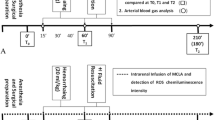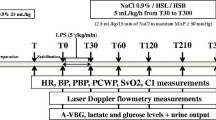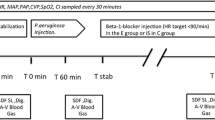Summary
Experiments were carried out on 183 rats to study the effect of a complex therapy for treatment of mesenteric shock. The superior mesenteric artery (SMA) was temporarily ligated for 90 min under ether anesthesia; this was followed by an analgesic treatment. After release of the ligated artery, fluid therapy was instituted by administering the equivalent of 7.5% of body weight of one of three different solutions: ringer lactate (RL), hydroxyethyl starch (HES) in RL, and perfluorochemicals (PFC, 4g/kg b.wt. in RL with HES), the latter with the aim to improve the oxygen transport to the tissue. The same fluid therapy was carried out on rats pretreated withE. coli endotoxin. Endotoxin pretreatment was chosen to compensate the negative effect of PFC on the reticuloendothelial system (RES) as shown in previous studies [15]. Survival time and survival rate were recorded as well as hematocrit values at different times before and after treatment.
Experimental groups were:Controls: (1) SMA occlusion without release; (2) 90-min occlusion without therapy.Treated animals: (3) RL therapy; (4) therapy with HES in RL; (5) therapy with PFC in RL and HES; (6), (7), and (8) identical therapies as Groups 3, 4, and 5, respectively, but with endotoxin pretreatment.
Survival time increased to the same extent if HES or PFC were added to RL. There was a further increase both in survival times and rates with endotoxin pretreatment (Groups 6, 7, and 8 vs. Groups 3, 4, and 5). The highest survival time and rate were obtained in Group 8, which received PFC therapy with endotoxin pretreatment. There was a slight negative correlation between survival time and hematocrit values if all groups were considered together. It was found that the most effective antishock treatment combines fluid therapy with a higher O2 content in the blood, achieved by the PFC emulsion, but that this combination was effective only under a pretreatment stimulating the RES. A further goal is to look for other mechanisms circumventing the need for the pretreatment part of therapy.
Similar content being viewed by others
References
Blattberg B, Levy MN (1962) Mechanism of action of reticuloendothelial system in shock. Am J Physiol 203:111–114
Boettcher I, Gash J, Lohr H, Lindner P (1975) Bestimmung des intravasalen Volumenverlustes beim Arteria mesenterica superior-Schock der Ratte und Versuche zur adäquaten Substitutionstherapie. Langenbecks Arch Chir Suppl Chir Forum 191–195
Bounous G (1967) Role of intestinal contents in the pathophysiology of acute intestinal ischemia. Am J Surg 114:368–375
Cameron GR, Khanna SD (1959) Regeneration of the intestinal villi after extensive mucosal infarction. J Pathol Bacteriol 77:505–511
Child CJ, Scott HJ, Gurd FN (1972) Volume deficit versus toxic absorption: A study of canine shock after mesenteric arterial occlusion. Ann Surg 175:479–488
Fine J, Frank ED, Ravin HA, Rutenberg SH, Schweinburg FB (1959) The bacterial factor in traumatic shock. N Engl J Med 260:214–220
Glotzer DJ, Villegas AH, Anekayama S, Shaw RS (1962) Healing of the intestine in experimental bowel infarction. Ann Surg 155:183–189
Haglind E, Bengtsson JP, Falk A, Haglund U, Lundgren O, Schersten T (1986) Intestinal vascular obstruction in the cat. Right heart function in a shock model. Res Exp Med (Berl) 186:285–294
Haglund U (1973) The small intestine in hypotension and hemorrhage. Acta Physiol Scand [Suppl] 387:1–37
Hartley HO (1950) The maximum F — ratio as a short-cut test for heterogeneity of variance. Biometrika 37:308–312
Juhasz M, Hamar J, Dezsi L, Feher E (1984) Effect of vascular perfusion on the regeneration of the small intenstine after prolonged ischemia. Kiserletes Orvostudomany (in Hungarian) 36:304–310
Lillehei RC (1957) The intestinal factor in irreversible shock. Surgery 42:1043–1054
Lutz J (1983) Studies on RES function in rats and mice after different doses of fluosol. In: Bolin RB, Geyer RP, Nemo GJ (eds) Advances in blood substitute research. Liss, New York, pp 197–208
Lutz J, Barthel U, Metzenauer P (1982) Variation in toxicity ofEscherichia coli endotoxin after treatment with perfluorated blood substitutes in mice. Circ Shock 9:99–106
Lutz J, Metzenauer P (1980) Effects of potential blood substitutes (perfluorochemicals) on rat liver and spleen. Pfluegers Arch 387:175–181
Marston A (1963) Causes of death in mesenteric arterial occlusion. I. Local and general effects of devascularisation of the bowel. Ann Surg 158:952–959
Messmer K, Sunder-Plassmann L, Jesch F, Görnandt L, Sinagowitz E, Kessler M (1973) Oxygen supply to the tissues during limited normovolemic hemodilution. Res Exp Med (Berl) 159:152–166
Mitsuno T, Ohyanagi H, Naito R (1982) Clinical studies of a perfluorochemical whole blood substitute (Fluosol-DA) In: Frey R, Beisbarth H, Stosseck K (eds) Oxygen-carrying colloidal blood substitutes. Zuckschwerdt, München, pp 30–40
Okamoto H, Yamanouchi K, Tokoyama K (1975) Retention of perfluorochemicals in circulating blood and organs of animals after intravenous injection of their emulsions. Chem Pharm Bull (Tokyo) 23:1452–1457
Sachs H (1984) Angewandte Statistik. Springer, Berlin Heidelberg New York
Selkurt EE (1959) Intestinal ischemic shock and the protective role of the liver. Am J Physiol 197:281–285
Shapiro PB, Bronsther B, Frank ED, Fine J (1958) Host resistance to hemorrhagic shock. XI. Role of deficient flow through the intestine in development of irreversibility. Proc Soc Exp Biol Med 97:372–376
Tremper KK, Friedman AE, Levine EM, Lapin PR, Camarillo D (1982) The preoperative treatment of severely anemic patients with a perfluorochemical oxygen-transport fluid, Fluosol-DA. N Engl J Med 307:277–283
Wagner R (1979) Ischämische Schädigung und postischämische Regeneration der Dünndarmschleimhaut. Thesis, Johannes Gutenberg Universität, Mainz
Wallenstein S, Zucker CL, Fleiss JL (1980) Some statistical methods useful in circulation research. Circ Res 47:1–9
Zweifach BW, Grodon HA, Wagner M, Reyniers SA (1958) Irreversible hemorrhagic shock in germ-free rats. J Exp Med 107:437–440
Author information
Authors and Affiliations
Additional information
Partly supported by the Dept. of Health of Hungary, grant No. TPB-EüM-05 and by the Deutsche Forschungsgemeinschaft, Lu 162/7.
Rights and permissions
About this article
Cite this article
Hamar, J., Dezsi, L., Adam, E. et al. Role of fluid replacement, increased oxygen availability by perfluorochemicals and enhanced RES function in the treatment of mesenteric occlusion shock. Res. Exp. Med. 187, 451–459 (1987). https://doi.org/10.1007/BF01852183
Received:
Accepted:
Issue Date:
DOI: https://doi.org/10.1007/BF01852183




